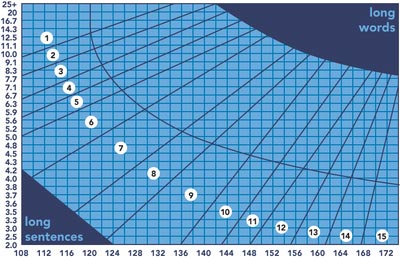Last update : July 17, 2013
Readability metrics are used to evaluate the ease in which text can be read and understood. Legibility is a measure of how easily individual letters or characters can be distinguished from each other.
Easy reading helps learning and enjoyment. There are different ways to test the readability of texts : text leveling, vocabulary frequency lists, affixes, readability metrics. In 1948, Rudolf Flesch published his Reading Ease formula which became one of the most widely used. In 1975, in a project sponsored by the U.S. Navy, the Reading Ease formula was recalculated to give a grade-level score and is now called the Flesch–Kincaid Grade-Level formula.

Fry Graph Readability Metrics
There are other readability metrics : Dale–Chall, Gunning Fog Index, Coleman-Liau Index, McLaughlin’s SMOG Index, Fry metrics, FORCAST, …
Clear, succinct writing designed to ensure the reader understands as quickly and completely as possible is called plain language. Using excess of words is called verbosity. A list of plain English words and phrases which have been recommended in United States guides to writing is available at Wikipedia.
Readability tests are often integrated in word processing applications and blog editors. A few links to online readability calculators are listed below :
- Readability-Score.com, by Added Bytes
- Readability Calculator, by Mladen Adamovic
- Readability analyzer, by approsto
- Fry Graph Tool, by California State University
